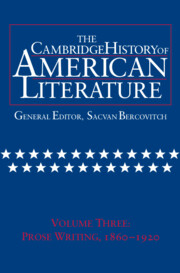Book contents
- Frontmatter
- Introduction
- THE AMERICAN LITERARY FIELD, 1860–1890
- LITERARY FORMS AND MASS CULTURE, 1870–1920
- 1 Museum Realism
- 2 Howells, James, and the republic of letters
- 3 Women and Realist authorship
- 4 Chesnutt and imperial spectacle
- 5 Wharton, travel, and modernity
- 6 Adams, James, Du Bois, and social thought
- PROMISES OF AMERICAN LIFE, 1880–1920
- BECOMING MULTICULTURAL: CULTURE, ECONOMY, AND THE NOVEL, 1860–1920
- Chronology 1860–1920
- Bibliography
- Index
5 - Wharton, travel, and modernity
from LITERARY FORMS AND MASS CULTURE, 1870–1920
Published online by Cambridge University Press: 28 March 2008
- Frontmatter
- Introduction
- THE AMERICAN LITERARY FIELD, 1860–1890
- LITERARY FORMS AND MASS CULTURE, 1870–1920
- 1 Museum Realism
- 2 Howells, James, and the republic of letters
- 3 Women and Realist authorship
- 4 Chesnutt and imperial spectacle
- 5 Wharton, travel, and modernity
- 6 Adams, James, Du Bois, and social thought
- PROMISES OF AMERICAN LIFE, 1880–1920
- BECOMING MULTICULTURAL: CULTURE, ECONOMY, AND THE NOVEL, 1860–1920
- Chronology 1860–1920
- Bibliography
- Index
Summary
MODERN VELOCITIES AND THE “POSSIBLE CRASH”
Edith Wharton loved the sensation of speed. In The Custom of the Country (1913), when Wharton writes of the “rush of physical joy” that comes from flying in an open car at twilight through the wintry boulevards of Central Park, the passage bespeaks her own infatuation with motor cars and their mechanical power. For Wharton, local motor-flights and transatlantic travel were fundamental conditions of living. Henry James always pictured her “wound up and going”; in alarm and bemusement his letters define her through “her dazzling, her incessant braveries of far excursionism.” Edith Wharton loved speed almost as much as she loved stillness – the contemplative space of gardens, the quiet stimulation of indoor conversation, the nearly motionless concentration necessary for the work of writing. These contraries – mobility and reflective stillness – inform Wharton's complex stance as an observer of modern life. Her taste for speed and travel on one hand, and the rooted critical focus she achieved in her writing on the other, reflect Wharton's divided attitude towards the kind of world she saw emerging in the first two decades of the twentieth century.
Critics generally agree that Wharton possessed an “anti-modernist” outlook, a skeptical and largely disapproving perspective on the changing mores of her time. In Wharton's eyes, the erosion of traditional social orders and the rise of mass culture threatened to damage beyond repair the kind of rich interior life she prized most. But whereas some scholars see these sentiments as the fears of an entrenched conservative, others see Wharton’s anti-modernism as part of her forward-looking analysis of misogynist and totalitarian impulses that came to fruition in the 1930s.
- Type
- Chapter
- Information
- The Cambridge History of American Literature , pp. 224 - 246Publisher: Cambridge University PressPrint publication year: 2005
- 1
- Cited by

